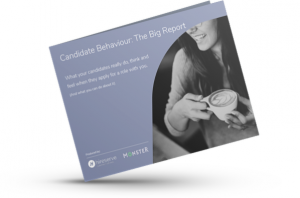Candidate behaviour research: What lessons can we learn?
We recently explored the rising rate of vacancies across the UK jobs market, and the talent shortages faced by some sectors.
We looked at everything from the importance of a strong EVP to ensuring recruitment processes are accessible and inclusive. But now it’s time to turn our attentions to the candidates themselves.
What can we learn from them to help hire the talent we so urgently need?

Candidate confidence is low
In our research, Candidate Behaviour: The Big Report, well over half (58%) of candidates would not apply for a role if they didn’t feel that they could meet all of the job criteria.
Perhaps unsurprisingly, this number increased to 63% when we focused on women. (For more insights on gender and the recruitment process, this post is for you!).
But the most marked increase was in our youngest demographic. A huge 77% of candidates aged 18 – 24% agreed that they wouldn’t apply for a job if they weren’t confident that they could meet all the requirements.
The ONS reported that large proportions of young people were employed in industries such as wholesale and retail, and accommodation and food service activities.[1] As a result, these workers have been some of those most at risk of unemployment throughout the pandemic.
Now, as these sectors continue to recover and seek to recruit once more, those same young workers may be struggling with their confidence to seek work or apply for roles.
What can we learn from this? If you’re recruiting in an industry that relies heavily on a younger workforce, consider how your job descriptions could read to less experienced applicants. Are all your ‘essential’ criteria really vital? And could a long list of requirements be off-putting to potential young candidates.
You can also try to clearly promote training and support for employees in your recruitment advertising. This may help to encourage younger candidates, or those who have been out of the labour market for some time, to apply.
Use simple, accessible language in your job descriptions. Avoid using gendered phrases, industry jargon, or terminology which may not be inclusive.
Candidates expect feedback
You knew this one would be on the list, didn’t you?
Yes, it’s the candidate frustration which always makes the headlines, yet somehow never seems to be fully solved. Lack of feedback – particularly after interviews.
In our candidate behaviour research, many, many respondents expressed their frustration when feedback was not provided. Some felt it indicated a lack of respect or support from the employer, whilst others commented that an organisation’s approach to feedback reflected their company culture.
In fact, 73% of our respondents agreed that detailed feedback should be provided post-interview – without them having to request it.
What can we learn from this? We know that time and resource is always a challenge for in-house recruitment teams, particularly during this time of high-volume hiring and increasing vacancies.
Providing feedback can be particularly testing when you don’t have an Applicant Tracking System or similar tech in place. An ATS can automate your recruitment communications, so at the very least you can trigger automatic application acknowledgements, or provide updates via a candidate portal.
Even if you have an ATS in place, you may not have had the time (or support) to configure your communications properly.
If your supplier can’t support you with this, or you don’t have recruitment technology, the most effective thing you can do is to manage candidate expectations. Will you struggle to provide feedback at each stage of your hiring process? Be clear about this when candidates apply. It can help to humanise these messages too (where appropriate and in-line with your EVP).
We have a whole host of feedback guidance and tips over here for you.
Company culture and benefits matter
When you’re seeking new talent, consider what makes your organisation unique. What can you offer staff in terms of support, perks and culture (and, crucially, what makes you a better choice than your competitors?).
Whilst ‘free fruit’ and ‘ping pong tables’ have been lampooned in recent years as being empty markers of a company culture, genuinely valuable staff benefits are still important to candidates.
In our candidate behaviour research, we discovered that the vast majority (70%) of all responded agreed that staff benefits were important.
Even more significant was an organisation’s approach to D&I (73% candidates agreed that this was important to them), and an employer’s commitment to helping the environment (74%).
What can we learn from this? Clearly display your organisation’s vision, values and approach to topics like D&I or the environment on your job descriptions and careers sites.
Where relevant, you should also share information about the staff benefits that you provide, from gym memberships to health insurance. It is essential to be authentic here, and to only promote benefits that deliver real value and support to your team members. Candidates are increasingly savvy about jargon or buzzwords, and will know when ‘bustling town centre location!’ translates as ‘industrial estate with one sandwich shop.
Beyond perks, focus too on the career progression and development that candidates could expect if they work with you. This may be particularly important to those whose livelihoods have been disrupted by the pandemic, and who may have had to move jobs, industries, faced furlough or faced unemployment.
Remember what it feels like to look for a new job
We mentioned this in a previous post (and probably will do multiple in future ones!) but for us the key is this: Don’t forget what it feels like to apply for a role. Don’t forget how to be human.
Even with powerful technology (Hireserve ATS you say?), you can still make a human connection with candidates. Avoid lists of duties and jargon that may dissuade younger or less confident candidates from applying for a role with you. Manage candidate expectations around feedback. And think about what benefits and staff support will really make a difference to your team’s journey with you.
Be authentic. Kind. Human. And go get the fantastic talent you need.

Are you looking for more insights into how your candidates think, feel and act during the recruitment journey? From research to attitudes towards online interviews, we cover it all in Candidate Behaviour: The Big Report – one of the most comprehensive research reports in the industry.
Created in partnership with Monster, we asked jobseekers across the country, of all ages and working in a wide range of sectors, to tell us how they act, think and feel during the hiring process. So, for a deep dive into your candidates and how they feel, download your report today!
[1] ONS report, March 2021



